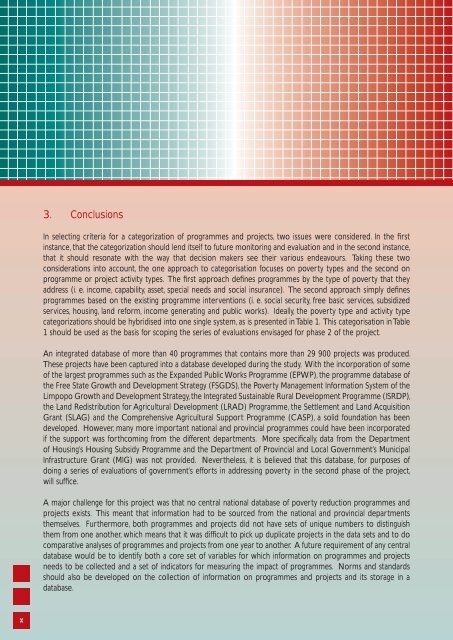Report on an Audit of Government's Poverty Reduction Programmes ...
Report on an Audit of Government's Poverty Reduction Programmes ...
Report on an Audit of Government's Poverty Reduction Programmes ...
Create successful ePaper yourself
Turn your PDF publications into a flip-book with our unique Google optimized e-Paper software.
3. C<strong>on</strong>clusi<strong>on</strong>sIn selecting criteria for a categorizati<strong>on</strong> <strong>of</strong> programmes <strong>an</strong>d projects, two issues were c<strong>on</strong>sidered. In the fi rstinst<strong>an</strong>ce, that the categorizati<strong>on</strong> should lend itself to future m<strong>on</strong>itoring <strong>an</strong>d evaluati<strong>on</strong> <strong>an</strong>d in the sec<strong>on</strong>d inst<strong>an</strong>ce,that it should res<strong>on</strong>ate with the way that decisi<strong>on</strong> makers see their various endeavours. Taking these twoc<strong>on</strong>siderati<strong>on</strong>s into account, the <strong>on</strong>e approach to categorisati<strong>on</strong> focuses <strong>on</strong> poverty types <strong>an</strong>d the sec<strong>on</strong>d <strong>on</strong>programme or project activity types. The fi rst approach defi nes programmes by the type <strong>of</strong> poverty that theyaddress (i. e. income, capability, asset, special needs <strong>an</strong>d social insur<strong>an</strong>ce). The sec<strong>on</strong>d approach simply defi nesprogrammes based <strong>on</strong> the existing programme interventi<strong>on</strong>s (i. e. social security, free basic services, subsidizedservices, housing, l<strong>an</strong>d reform, income generating <strong>an</strong>d public works). Ideally, the poverty type <strong>an</strong>d activity typecategorizati<strong>on</strong>s should be hybridised into <strong>on</strong>e single system, as is presented in Table 1. This categorisati<strong>on</strong> in Table1 should be used as the basis for scoping the series <strong>of</strong> evaluati<strong>on</strong>s envisaged for phase 2 <strong>of</strong> the project.An integrated database <strong>of</strong> more th<strong>an</strong> 40 programmes that c<strong>on</strong>tains more th<strong>an</strong> 29 900 projects was produced.These projects have been captured into a database developed during the study. With the incorporati<strong>on</strong> <strong>of</strong> some<strong>of</strong> the largest programmes such as the Exp<strong>an</strong>ded Public Works Programme (EPWP), the programme database <strong>of</strong>the Free State Growth <strong>an</strong>d Development Strategy (FSGDS), the <strong>Poverty</strong> M<strong>an</strong>agement Informati<strong>on</strong> System <strong>of</strong> theLimpopo Growth <strong>an</strong>d Development Strategy, the Integrated Sustainable Rural Development Programme (ISRDP),the L<strong>an</strong>d Redistributi<strong>on</strong> for Agricultural Development (LRAD) Programme, the Settlement <strong>an</strong>d L<strong>an</strong>d Acquisiti<strong>on</strong>Gr<strong>an</strong>t (SLAG) <strong>an</strong>d the Comprehensive Agricultural Support Programme (CASP), a solid foundati<strong>on</strong> has beendeveloped. However, m<strong>an</strong>y more import<strong>an</strong>t nati<strong>on</strong>al <strong>an</strong>d provincial programmes could have been incorporatedif the support was forthcoming from the different departments. More specifi cally, data from the Department<strong>of</strong> Housing’s Housing Subsidy Programme <strong>an</strong>d the Department <strong>of</strong> Provincial <strong>an</strong>d Local Government’s MunicipalInfrastructure Gr<strong>an</strong>t (MIG) was not provided. Nevertheless, it is believed that this database, for purposes <strong>of</strong>doing a series <strong>of</strong> evaluati<strong>on</strong>s <strong>of</strong> government’s efforts in addressing poverty in the sec<strong>on</strong>d phase <strong>of</strong> the project,will suffi ce.A major challenge for this project was that no central nati<strong>on</strong>al database <strong>of</strong> poverty reducti<strong>on</strong> programmes <strong>an</strong>dprojects exists. This me<strong>an</strong>t that informati<strong>on</strong> had to be sourced from the nati<strong>on</strong>al <strong>an</strong>d provincial departmentsthemselves. Furthermore, both programmes <strong>an</strong>d projects did not have sets <strong>of</strong> unique numbers to distinguishthem from <strong>on</strong>e <strong>an</strong>other, which me<strong>an</strong>s that it was diffi cult to pick up duplicate projects in the data sets <strong>an</strong>d to docomparative <strong>an</strong>alyses <strong>of</strong> programmes <strong>an</strong>d projects from <strong>on</strong>e year to <strong>an</strong>other. A future requirement <strong>of</strong> <strong>an</strong>y centraldatabase would be to identify both a core set <strong>of</strong> variables for which informati<strong>on</strong> <strong>on</strong> programmes <strong>an</strong>d projectsneeds to be collected <strong>an</strong>d a set <strong>of</strong> indicators for measuring the impact <strong>of</strong> programmes. Norms <strong>an</strong>d st<strong>an</strong>dardsshould also be developed <strong>on</strong> the collecti<strong>on</strong> <strong>of</strong> informati<strong>on</strong> <strong>on</strong> programmes <strong>an</strong>d projects <strong>an</strong>d its storage in adatabase.x









![National Research Foundation Annual Report 2008 / 2009 [Part 2]](https://img.yumpu.com/49774036/1/177x260/national-research-foundation-annual-report-2008-2009-part-2.jpg?quality=85)







